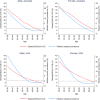The role of overweight and obesity in adverse cardiovascular disease mortality trends: an analysis of multiple cause of death data from Australia and the USA
- PMID: 32746822
- PMCID: PMC7401233
- DOI: 10.1186/s12916-020-01666-y
The role of overweight and obesity in adverse cardiovascular disease mortality trends: an analysis of multiple cause of death data from Australia and the USA
Abstract
Background: In recent years, there have been adverse trends in premature cardiovascular disease (CVD) mortality rates (35-74 years) in the USA and Australia. Following long-term declines, rates in the USA are now increasing while falls in Australia have slowed rapidly. These two countries also have the highest adult obesity prevalence of high-income countries. This study investigates the role of overweight and obesity in their recent CVD mortality trends by using multiple cause of death (MCOD) data-direct individual-level evidence from death certificates-and linking the findings to cohort lifetime obesity prevalence.
Methods: We identified overweight- and obesity-related mortality as any CVD reported on the death certificate (CVD MCOD) with one or more of diabetes, chronic kidney disease, obesity, lipidemias or hypertensive heart disease (DKOLH-CVD), causes strongly associated with overweight and obesity. DKOLH-CVD comprises 50% of US and 40% of Australian CVD MCOD mortality. Trends in premature age-standardized death rates were compared between DKOLH-CVD and other CVD MCOD deaths (non-DKOLH-CVD). Deaths from 2000 to 2017 in the USA and 2006-2016 in Australia were analyzed. Trends in in age-specific DKOLH-CVD death rates were related to cohort relative lifetime obesity prevalence.
Results: Each country's DKOLH-CVD mortality rate rose by 3% per annum in the most recent year, but previous declines had reversed more rapidly in Australia. Non-DKOLH-CVD mortality in the USA increased in 2017 after declining strongly in the early 2000s, but in Australia it has continued declining in stark contrast to DKOLH-CVD. There were larger increases in DKOLH-CVD mortality rates at successively younger ages, strongly related with higher relative lifetime obesity prevalence in younger cohorts.
Conclusions: The increase in DKOLH-CVD mortality in each country suggests that overweight and obesity has likely been a key driver of the recent slowdown or reversal of CVD mortality decline in both countries. The larger recent increases in DKOLH-CVD mortality and higher lifetime obesity prevalence in younger age groups are very concerning and are likely to adversely impact CVD mortality trends and hence life expectancy in future. MCOD data is a valuable but underutilized source of data to track important mortality trends.
Keywords: Cardiovascular diseases; Chronic kidney disease; Diabetes; Hypertensive heart disease; Mortality; Multiple causes of death; Obesity.
Conflict of interest statement
The authors declare that they have no competing interests.
Figures




References
-
- Lopez AD, Adair T. Is the long-term decline in cardiovascular-disease mortality in high-income countries over? Evidence from national vital statistics. Int J Epidemiol. 2019;48(6):1815-23. - PubMed
-
- Raleigh VS. Trends in life expectancy in EU and other OECD countries: why are improvements slowing? Paris: OECD Health Working Paper No. 108. 2019.
MeSH terms
LinkOut - more resources
Full Text Sources
Medical

